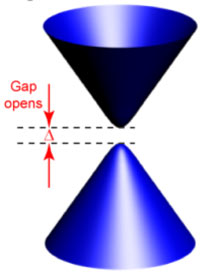
Handy Links
SLAC News Center
SLAC Today
- Subscribe
- Archives: Feb 2006-May 20, 2011
- Archives: May 23, 2011 and later
- Submit Feedback or Story Ideas
- About SLAC Today
SLAC News
Lab News
- Interactions
- Lightsources.org
- ILC NewsLine
- Int'l Science Grid This Week
- Fermilab Today
- Berkeley Lab News
- @brookhaven TODAY
- DOE Pulse
- CERN Courier
- DESY inForm
- US / LHC
SLAC Links
- Emergency
- Safety
- Policy Repository
- Site Entry Form

- Site Maps
- M & O Review
- Computing Status & Calendar
- SLAC Colloquium
- SLACspeak
- SLACspace
- SLAC Logo
- Café Menu
- Flea Market
- Web E-mail
- Marguerite Shuttle
- Discount Commuter Passes
-
Award Reporting Form
- SPIRES
- SciDoc
- Activity Groups
- Library
Stanford
Around the Bay
Topological Insulators Take Two Steps Forward

A team of researchers from the Stanford Institute of Materials and Energy Science, a joint institute of the Department of Energy's SLAC National Accelerator Laboratory and Stanford University, and their international collaborators have pushed research into topological insulators not just one, but two steps forward.
Taken together, both steps bring the unique material closer to use in the nascent technology of spintronics, with the potential to result in, among other advances, smaller, more efficient transistors and memory devices. Both steps could also give physicists from fields as varied as condensed matter physics, cosmology, and particle physics glimpses into such exotic phenomena as magnetic monopoles, the fractional quantum Hall effect and axion fields, for starters.
As explained in a paper appearing online today in Science, in step 1, Chen and his collaborators took the marvelous property of a three-dimensional topological insulator—in which electrons flow inexorably along the surface in the same direction, slaloming around defects instead of scattering off them in all directions—and broke it.
In step 2, the team demonstrated the ability to "tune" the topological insulator's Fermi energy level, the amount of energy in the most energetic electrons still occupying a specific quantum state.
Essentially, the team completely redrew the energy portrait for the topological insulator. Initially the portrait showed two cones, called Dirac cones, with their apexes touching at the so-called Dirac point, where electrons can cruise serenely along the insulator's surface. Introducing magnetic impurities into the system turns electrons into bumbling pedestrians that scatter and bounce off the impurities, in effect creating a gap separating the upper and lower Dirac cones. While tuned into that gap, the usually free flow of electrons across the material's surface remains "broken."
Chen and his collaborators accomplished this feat by first adding tiny amounts of magnetic materials to their topological insulator of choice, di-bismuth tri-selenide, and then adding materials that contributed either extra electrons or extra "holes"—places electrons already in the material might want to settle. Chen likened the process to having two control knobs, the B knob and the E knob. ("B" is a standard variable for magnetic fields in equations.)
"The B knob opens the gap (between Dirac cones) and the E knob adjusts the Fermi energy of the material," Chen said. "You need both."
The team spent months tuning the B and E knobs. On the practical side, they were able to transform the topological insulator into different varieties of semiconductors, an accomplishment that points the way toward semiconductor-based functional devices. On the research side, the team's most immediate contribution was to confirm theoretical predictions, but according to Chen their efforts have a more long-lasting benefit.
"This is a material base for many exciting future investigations," he said. And on this base, "Many exotic phenomena may be realized." How exotic? "In this condensed matter system, one electric charge can induce a magnetic monopole. If a future experiment confirms this, it'll be fascinating."
That's not all. The system might also provide a sort of analogy for an axion field, something cosmologists are on the hunt for, as well as demonstrating what's known as the fractional quantum Hall effect, in which the electrons as a group behave like quasiparticles with fractional charges.
Magnetically doped samples were grown by Jiun-Haw Chu and James Analytis of SIMES at Fisher Laboratory, Geballe Lab for Advanced Materials and Sasagawa group in Tokyo institute of Technology. ARPES measurements for this study were performed at Beamline 10.0.1 at the Advanced Light Source, Lawrence Berkeley National Laboratory, and at Beamline 5-4 of the Stanford Synchrotron Radiation Light Source
—Lori Ann White
SLAC Today, August 6, 2010